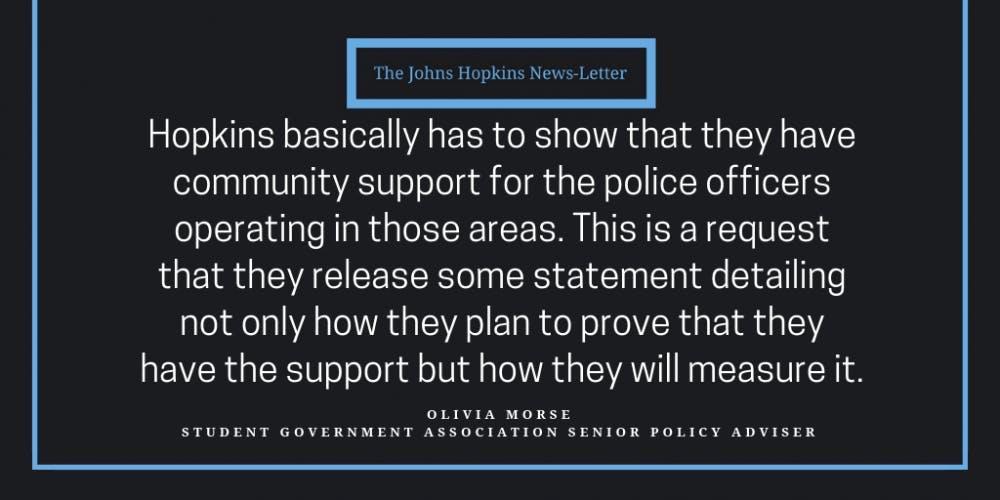The Student Government Association (SGA) held their final meeting of the 2018-19 academic year on Tuesday in Charles Commons. At the meeting, SGA members passed a resolution calling on the University to provide proof of community support and to hold two public forums before implementing a private police force.
They also passed a resolution calling for the creation of a University-wide council made up of students, faculty, staff and other stakeholders across Hopkins campuses.
Sophomore Olivia Morse, senior policy adviser of SGA’s Policy Research and Development Commission, authored the Resolution Concerning Private Police Force and SB793. She explained that Senate Bill (SB) 793, the bill that authorizes Hopkins to create a private police force, includes certain measures the University must take before it can implement the police force.
“One of the things is that wherever police officers would be present, Hopkins basically has to show that they have community support for the police officers operating in those areas,” Morse said. “This is a request that they release some statement detailing not only how they plan to prove that they have the support but how they will measure it.”
Morse elaborated that the resolution also requires the University to hold two public forums before it can implement the police force. Maryland Governor Larry Hogan signed legislation that will allow Hopkins to establish a private police force on April 18.
“We would ask that the University halt all further action on the implementation of a private police force until the public forums have been held and more specifically that these forums not be held until the beginning of the academic year,” Morse said.
She clarified that while this resolution would not be binding, it would signal to the University that students are aware of the legislation and will hold Hopkins accountable to all of the bill’s clauses. SGA voted to pass the resolution.
SGA also voted to pass the University-Wide Council Resolution, which Executive President AJ Tsang introduced. He explained that this resolution would support the creation of a council consisting of student, faculty and staff representation from across the University. According to Tsang, this would act as a platform for cross-campus collaboration.
“Say, for example, President Daniels or Provost Kumar has an initiative that could affect the whole University. This kind of council would allow them to access different stakeholders from across each campus which previously would have had to have been accessed individually,” he said. “This kind of council would bring together much of the siloing that has occurred across the University in the past few years.”
SGA members questioned how many members from each University division would serve on the council and how those members would be selected. Tsang admitted that while he does not know all the answers, he believes that the council have a positive impact on the future of all University campuses.
“This resolution at least calls for the existence of a council of some kind to represent these diverse and various voices from across the University in a way that hasn’t been really thought of before here at Hopkins,” he said. “In many ways this resolution sets the groundwork for what would come in the future.”
SGA members also passed the D.C. Monument Quilt Transportation Bill, which Tsang introduced. Tsang explained that members of the Sexual Assault Resource Unit, a group that supports survivors of sexual assault and advocates an end to sexual violence, and the community service organization Alpha Phi Omega wanted to sponsor a Johns Hopkins Medical Institutions (JHMI) shuttle to transport Hopkins students to see the Monument Quilt on June 1.
The Monument Quilt features survivors’ stories, written and stitched onto nearly 3,000 squares of red fabric. FORCE: Upsetting Rape Culture, a Baltimore-based arts and activist group, launched the Quilt in 2013. From May 31 to June 2, the Quilt will be displayed in its entirety for the first and only time in Washington, D.C. near the National Mall, culminating the project that FORCE has been working toward.
Junior Class Senator Madelynn Wellons commended the bill.
“The Monument Quilt is really, really empowering and incredibly wonderful for survivors of sexual violence,” she said.
Other senators suggested that it might be cheaper for SGA to fund MARC train tickets for all students interested in going to see the quilt.
Wellons noted, however, that this might raise accessibility or logistical issues.
Executive Treasurer Mi Tu pointed out that SGA didn’t have to fund the entire bill but rather could choose how much of their remaining budget of $1635 to allocate to each of the two funding bills on that day’s agenda.
SGA members decided to hear the details of the Airport Shuttle Bill, which Junior Class Senator Claire Gorman introduced.
Gorman presented on the Airport Shuttle Bill, noting that many Hopkins students require transportation to the Baltimore/Washington International Thurgood Marshall Airport to fly home at the start of each break.
“Multiple students brought up to me that they wished they had a free shuttle to the airport, so I looked into it, and transportation said they could do a Blue Jay Shuttle to and from the airport for $90 a ride for about 10 to 12 people,” she said.
SGA members ultimately voted to fund the D.C. Monument Quilt Transportation Bill and the Airport Shuttle Bill, for $800 each.
Many senators, including Freshman Class Senator Pritika Parmar, voiced their support for the latter.
“Right now, there’s this general consensus that SGA doesn’t do anything,” Parmar said. “This is something tangible we can do that would have a large impact.”





